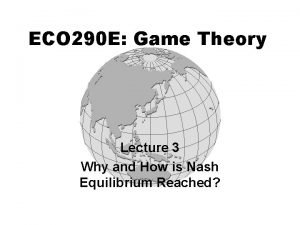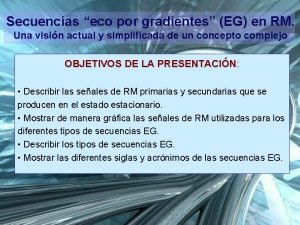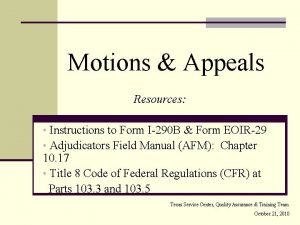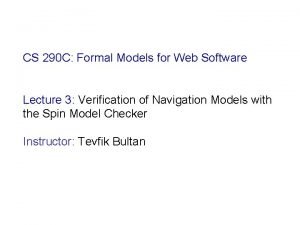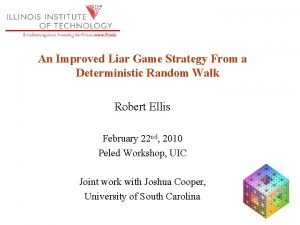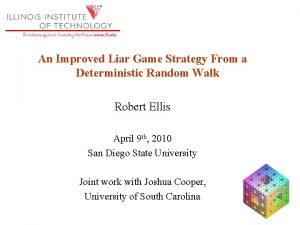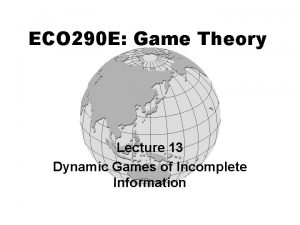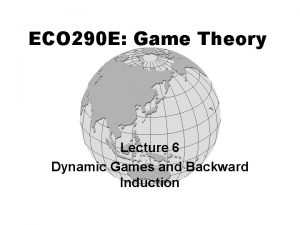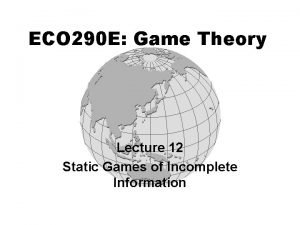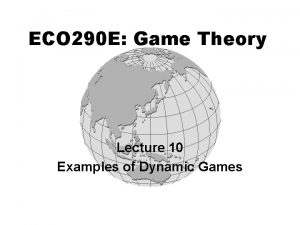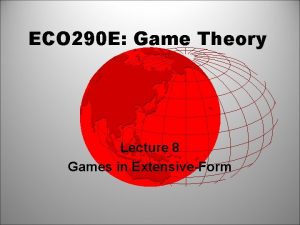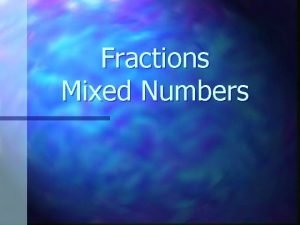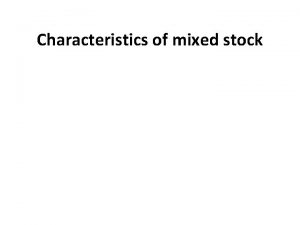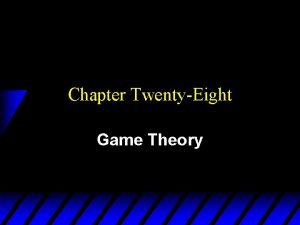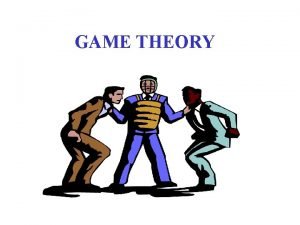ECO 290 E Game Theory Lecture 5 Mixed















- Slides: 15

ECO 290 E: Game Theory Lecture 5 Mixed Strategy Equilibrium

Zero-Sum Game • Matching Pennies Player Heads 2 Player 1 Heads Tails 1 -1 Tails -1 1 1 -1

No Nash Equilibrium? • The distinguishing feature of zero-sum game is that each player would like to outguess the other since there is no “win-win” situation. • Example: Porker (bluff or not), Battle (by land or by sea), Tennis (left or right to serve) • When each player would always like outguess the other(s), there is no Nash equilibrium. Þ Contradicting Nash’s theorem? ?

Mixed Strategy • A mixed strategy for a player is a probability distribution over some (or all) of her strategies. • The strategy we have studied so far, i. e. , taking some action for sure, is called a purestrategy. • When the outcome of the game is uncertain, we assume that each player maximizes expected value of her payoff. Þ Expected utility theory (von Neumann and Morgenstern, 1944)

Matching Pennies Again • Introducing mixed strategies Player 2 Player 1 Heads (q) Tails (1 -q) Heads (p) Tails (1 -p) 1 -1 -1 1 1 -1

How to Find Equilibrium? • If a player takes both “Heads” and “Tails” with positive probability, she must be indifferent between these two pure strategies, i. e. , the expected payoff derived by choosing Heads must be equal to that by choosing Tails. • -p+(1 -p)=p-(1 -p), hence p=0. 5. • q-(1 -q)=-q+(1 -q), hence q=0. 5.

How to Verify Equilibrium? • Note that if p=0. 5, Player 1 does not have a strict incentive to change her strategy from q=0. 5. • Similarly, Player 2 does not have a strict incentive to change his strategy from p=0. 5, if q=0. 5. Þ Therefore, p=q=0. 5 constitutes a mixedstrategy equilibrium. Q: Is this equilibrium reasonable/stable? A: Yes (each player ends up randomizing two strategies equally if the rival is smart enough).

Modified Matching Pennies • Suppose the payoffs in the up-left cell changes as the following: Player 2 Heads (p) Player 1 Heads (q) Tails (1 -p) 2 -2 -1 1 1 -1

Indifference Property • Under mixed-strategy NE, Player 1 must be indifferent between choosing H and T: Þ -2 p+(1 -p)=p-(1 -p), hence p=0. 4. • Similarly, Player 2 must be indifferent between choosing H and T: Þ 2 q-(1 -q)=-q+(1 -q), hence q=0. 4. • You can easily verify that (p, q)=(0. 4, 0. 4) indeed becomes a mixed-strategy NE.

Existence of NE Theorem (Nash, 1950) • If a game has finite number of players and actions, then there exists at least one Nash equilibrium, possibly involving mixed strategies. Þ The proof uses the Kakutani’s fixed-point theorem. Þ Best response mappings satisfy the condition of the fixed-point theorem, and hence have a fixed point, which is equivalent to a NE!

Infinite Games • The finite game assumption is not necessary but gives a sufficient condition for the existence of NE. • There are many games that do not satisfy the conditions of the Theorem but nonetheless have one or more NE. (e. g. , Bertrand model, Cournot model) Q: Are there any games which do not even have a mixed-strategy equilibrium? A: Yes, e. g. , Integer game.

Reporting a Crime • A crime is observed by a group of n people. Each person would like the police to be informed but prefers that someone else make the phone call. • Players: The n people. • Strategies: “Call” or “Don’t call” • Payoffs: 0 if no one calls. v if someone else calls but she does not. v-c if the player calls.

Pure-Strategy Equilibrium • This game has n pure-strategy NE, in each of which exactly one person calls. (if that person switches to not calling, her payoff falls from v-c to 0; if any other person switches to calling, his payoff falls from v to v-c. ) • If the members of the group differ in some respect, then these asymmetric equilibria may be compelling as steady states. • For example, the social norm in which the oldest person in the group makes the phone call is stable.

Mixed-Strategy Equilibrium • There is a symmetric mixed strategy equilibrium in which each person calls with positive probability p<1. • In any such equilibrium, each person’s expected payoff to calling is equal to her expected payoff to not calling. Þ v-c=v(1 -Pr{no one else calls}) Þ c/v=Pr{no one else calls} • Notice that the probability that no one else calls is independent of n, but constant!

Implication Pr{no one calls} =Pr{i does not call}x. Pr{no one else calls} =(1 -p)c/v • You can show that 1 -p is increasing in n, i. e. , the probability that person i does not call increases as n becomes larger. • This implies that the probability that no one calls is also increasing in n. Þ The larger the group, the less likely the police are informed of the crime!
 Eco 290
Eco 290 Secuencia spin eco
Secuencia spin eco 30 tac 290
30 tac 290 A 290. számú auschwitzi fogoly
A 290. számú auschwitzi fogoly Form i290
Form i290 Specs 290 and jones
Specs 290 and jones Cs 290
Cs 290 Myuiemployer
Myuiemployer Rametsi eco game farm
Rametsi eco game farm 01:640:244 lecture notes - lecture 15: plat, idah, farad
01:640:244 lecture notes - lecture 15: plat, idah, farad Pirate game grid
Pirate game grid Game lab game theory
Game lab game theory Liar game game theory
Liar game game theory Liar game game theory
Liar game game theory Game theory and graph theory
Game theory and graph theory Game design lecture
Game design lecture
